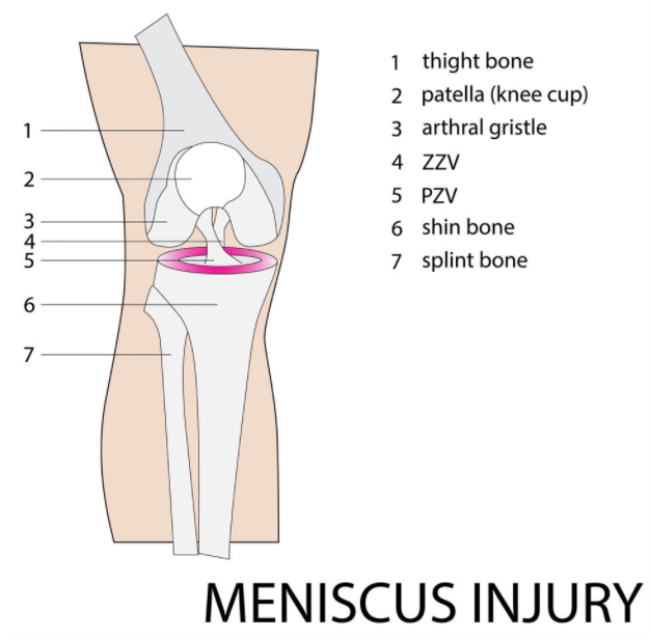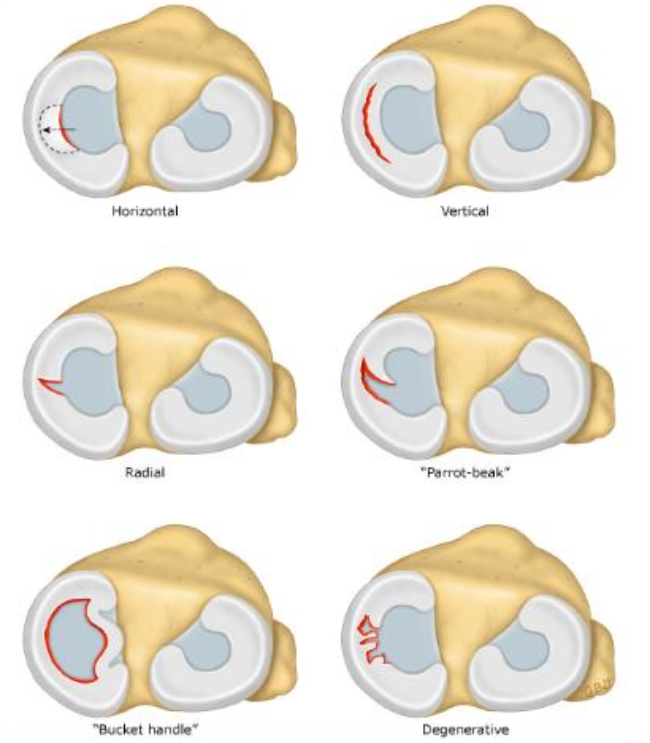Meniscus injury is one of the most common knee injuries, more common in young adults and more men than women.
The meniscus is a C-shaped cushioning structure of elastic cartilage that sits between the two main bones that make up the knee joint. The meniscus acts as a cushion to prevent damage to the articular cartilage from impact. Meniscal injuries can be caused by trauma or by degeneration. Meniscus injury caused by severe trauma can be complicated by knee soft tissue injury, such as collateral ligament injury, cruciate ligament injury, joint capsule injury, cartilage surface injury, etc., and is often the cause of post-injury swelling.
Meniscal injuries are most likely to occur when the knee joint moves from flexion to extension accompanied by rotation. The most common meniscus injury is the medial meniscus, the most common is the injury of the posterior horn of the meniscus, and the most common is the longitudinal rupture. The length, depth, and location of the tear depend on the relationship of the posterior meniscus angle between the femoral and tibial condyles. Congenital abnormalities of the meniscus, especially the lateral discoid cartilage, are more likely to lead to degeneration or damage. Congenital joint laxity and other internal disorders can also increase the risk of meniscus damage.
On the articular surface of the tibia, there are medial and lateral meniscus-shaped bones, called meniscus, which are thicker at the edge and tightly connected with the joint capsule, and thin at the center, which is free. The medial meniscus is "C"-shaped, with the anterior horn attached to the anterior cruciate ligament attachment point, the posterior horn attached between the tibial intercondylar eminence and the posterior cruciate ligament attachment point, and the middle of its outer edge is closely connected to the medial collateral ligament. The lateral meniscus is "O" shaped, its anterior horn is attached to the anterior cruciate ligament attachment point, the posterior horn is attached to the medial meniscus anterior to the posterior horn, its outer edge is not connected to the lateral collateral ligament, and its range of motion is less than that of the medial meniscus. big. The meniscus can move with the movement of the knee joint to a certain extent. The meniscus moves forward when the knee is extended and moves backward when the knee is flexed. The meniscus is a fibrocartilage that has no blood supply itself, and its nutrition mainly comes from the synovial fluid. Only the peripheral part connected to the joint capsule gets some blood supply from the synovium.
Therefore, in addition to the self-repair after the edge part is injured, the meniscus cannot be repaired by itself after the meniscus is removed. After the meniscus is removed, a fibrocartilaginous, thin and narrow meniscus can be regenerated from the synovium. A normal meniscus can increase the depression of the tibial condyle and cushion the inner and outer condyles of the femur to increase the stability of the joint and buffer shock.
The causes of meniscus injury can be roughly divided into two categories, one is caused by trauma, and the other is caused by degenerative changes. The former is often violent to the knee due to acute injury. When the knee joint is flexed, it does strong valgus or varus, internal rotation or external rotation. The upper surface of the meniscus moves with the femoral condyle to a greater extent, while the rotational friction shear force is formed between the lower surface and the tibial plateau. The force of sudden movements is very large, and when the rotating and crushing force exceeds the allowable range of motion of the meniscus, it can cause damage to the meniscus. The meniscus injury caused by degenerative changes may have no obvious history of acute injury. It is usually due to the frequent need to work in a semi-squatting position or a squatting position, and repeated knee flexion, rotation and extension for a long time. The meniscus is repeatedly squeezed and worn away. lead to lacerations.
Prevention:
Since the lateral meniscus is not connected to the lateral collateral ligament, the range of motion is greater than that of the medial meniscus. In addition, the lateral meniscus often has congenital discoid deformities, called congenital discoid meniscus. Therefore, there are more chances of damage.
Meniscus injuries are more common in ball players, miners, and porters. When the knee joint is fully extended, the medial and lateral collateral ligaments are tight, the joint is stable, and the chance of meniscus injury is less. When the lower extremity is weight-bearing, the foot is fixed, and the knee joint is in the semi-flexion position, the meniscus moves backward. torn.
To prevent meniscus injury, it is mainly to pay attention to knee joint injury in daily life, to warm up before exercise, to fully exercise the joint, and to avoid sports injury during exercise. Older people are advised to reduce strenuous confrontational sports, such as basketball, football, rugby, etc., due to the decline of body coordination and the elasticity of muscle ligaments. If you must participate in strenuous confrontational sports, you should also pay attention to what you can do and avoid doing difficult movements, especially the movements of bending your knees and turning around. After exercising, you should also do a good job of relaxing as a whole, pay attention to rest, avoid fatigue, and avoid getting cold.
You can also train the muscles around the knee joint to strengthen the stability of the knee joint and reduce the risk of knee meniscus damage. In addition, patients should pay attention to a healthy diet, eat more green vegetables and high-protein and high-calcium foods, reduce fat intake, and lose weight, because excessive weight-bearing will reduce the stability of the knee joint.
Post time: Oct-13-2022












